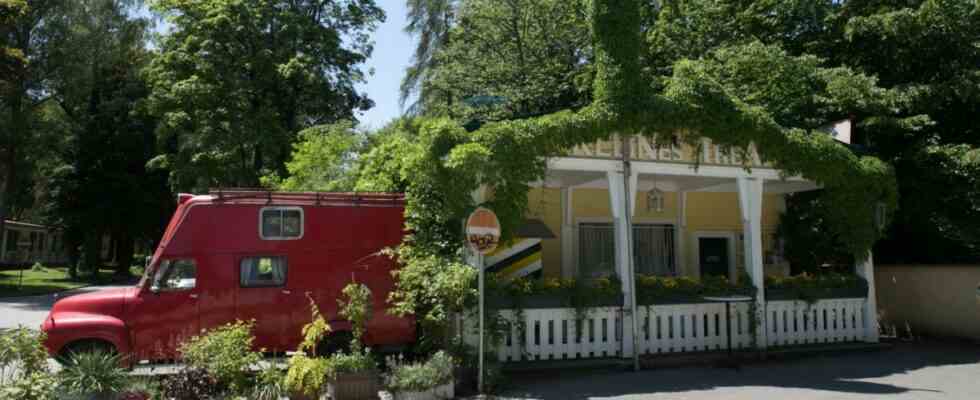“Art needs space and costs money.” The words of Liselotte Bothe bundle the statements of the artists, artists and musicians who can live out their creativity in the Bürgerpark Oberföhring. There, between the low-rise buildings of the former hospital on Oberföhringer Straße, there are small gardens with inviting tables and benches, and the first early bloomers are stretching their petals towards the sun.
Bothe, contact person of the Bürgerpark Oberföhring interest group and operator of the puppet theater in the gatehouse of the former military hospital, opens the doors to the artists’ worlds: it is bright in the barracks, light streams through the skylights into the exhibition rooms, in the studios there are colorful sculptures, stacked papers and large format paintings. In another building, the light is dimmed, records are stacked on the shelves, and posters are stuck to the walls: the subculture lives on in the café cult.
Liselotte Bothe has been performing on the puppet stage in the small theater in the gatehouse for many years.
(Photo: Robert Haas)
The use of the building for Bogenhausen’s clubs was only intended as a temporary solution in the 1980s, but the temporary solution has become established. But no matter how much clubs and artists have upgraded the barracks in detail work and on their own initiative, the houses are still aged and renovation work is necessary. But the users cannot easily carry out larger works, because the building and use permit for the buildings expires again in 2025. The 1992 development plan does not envisage permanent preservation of the barracks.
The city is planning a joint new building – to the annoyance of the users
At the end of February, the SPD/Volt parliamentary group and the Greens/Pink List parliamentary group submitted an application in which the culture department, together with the construction, municipal and planning departments, was asked to check the conditions under which the building and usage permit was granted of the building can be extended indefinitely beyond 2025. Julia Schönfeld-Knor, cultural policy spokeswoman for the SPD/Volt, speaks of a “very mature structure that looks back on a long tradition”. The clubs and projects would have uncomplicated and simple rooms available there, “that’s something very unusual in our city”. The cultural department also calls the unique and unusual mixture of diverse cultural, artistic, social and socio-cultural uses, combined with ecological diversity and high recreational quality, worth preserving.
Now ways and means are to be found to preserve this grown structure in a new conception of the site, says Schönfeld-Knor. Citizens and associations are to be included in this process. Thorsten Vogel from the department for urban planning and building regulations also speaks of the goal of a sensible and permanent option for diverse uses. However, an unlimited permit for the barracks, which many of the clubs based there would like, cannot be implemented because they do not correspond to the legally binding development plan. A replacement building is planned.
The former city hospital – the former driveway for ambulances in the picture – has long been a domicile for creative groups.
(Photo: Florian Peljak)
However, this alternative is neither in the sense of Liselotte Bothe nor of Karin Vetterle and Anneliese Menghini from Vereinsgemeinschaft 29 (VG 29). They are convinced that the subculture cannot live out in a single cultural building in the way it has developed in the Bürgerpark. There, clubs such as the Feringa carnival society, the square dancers or the hovercraft club, but also independent artists and musicians have room for creative work, which would be threatened if they were merged into a single house. And it is precisely this heterogeneity and the opportunities for development that the Bürgerpark offers thanks to the art and culture sponsorship that make Munich more lively and worth living in, says Andre Syrbe, artist and studio user. According to VG 29, it is already sometimes difficult to distribute all inquiries to the available premises.
Clubs could disappear
Bothe with their Kasperltheater, Josef Wagner from the Bayerische Volksbühne Watzmann and also Vetterle and Menghini are certain that sooner or later the clubs and projects would disappear if the permit expired. There are currently no alternatives that are equivalent to the current concept, says Wagner. Nevertheless, the contact to those responsible is given, confirms Vetterle. However, there is a lack of external impact, although projects such as the Volksbühne, the Kasperltheater or the alternative music scene attract visitors from all over the world, says Bothe.
Creativity has its place in the Bürgerpark.
(Photo: Catherine Hess)
However, this perception must be carried further into everyday life in Munich. Cooperation with schools and kindergartens is a step in the right direction. The VG29 and Bothe emphasize how important it is that Munich understands how necessary the open space in the Bürgerpark is for the Munich subcultures. With more attention and understanding of this, diversity could be preserved and the permit extension could be enforced. One more time.

